![]()
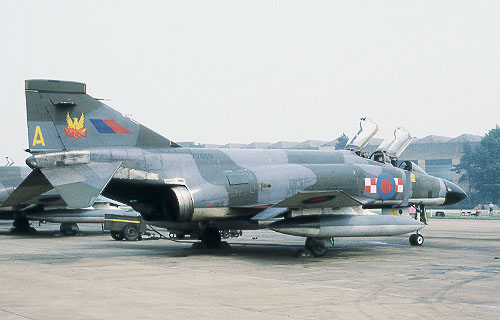 Part
five: Phantastic Phantom's arrival by
Dave Eade
Part
five: Phantastic Phantom's arrival by
Dave Eade
Not many can boast of receiving even one Phantom for their birthday. On 25 February 1976 (my 32nd), I was privileged to watch the arrival of 23 Squadron complete with a diamond-nine plus box-four of newly painted F4M Phantom FGR2s. So, Wattisham moved from being Lightning equipped to a much more sophisticated piece of kit. It seemed that the Phantom was built to replace the Lightning in that it remedied all the so-called shortcomings decried of its predecessor. So often in British aviation history, politics has been the bigger enemy, and the insistence on some forty percent of the F4K and M version being of UK manufacture added more shortfalls than benefits. The vast reshaping of the rear end to accommodate two Rolls Royce Spey engines gave the RAF the slowest and heaviest of all the Phantom variants, we are led to believe.
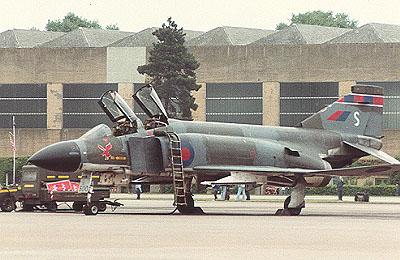 Armed
with a massive four Sparrow air to air missile (up-rated to Skyflash eventually)
and four Sidewinders, the F4M was also capable of fielding the Vulcan
rotary cannon. With a radar kit borne of the Vietnam campaign but steadily
up-graded (a bonus not allowed for the Lightning) it become probably the
best in Europe. A Phantom's range was such that the need for airborne
QRA tankers disappeared overnight. A standard fit would include all eight
missiles, plus a fuel tank on each wing and one on centre-line.
Armed
with a massive four Sparrow air to air missile (up-rated to Skyflash eventually)
and four Sidewinders, the F4M was also capable of fielding the Vulcan
rotary cannon. With a radar kit borne of the Vietnam campaign but steadily
up-graded (a bonus not allowed for the Lightning) it become probably the
best in Europe. A Phantom's range was such that the need for airborne
QRA tankers disappeared overnight. A standard fit would include all eight
missiles, plus a fuel tank on each wing and one on centre-line.
Once both 23 and 56 squadrons
became Phantom equipped, Wattisham settled into the routine of deployments,
exercises and QRA that was a fighter base in the latter seventies and
eighties. When received onto the squadrons, Phantom aircraft were painted
in the ubiquitous standard camouflage grey-green scheme. Squadron markings
altered subtly as the years went by, but it fell to 56 Squadron to pioneer
a change in finding a colour-scheme more fitting for air defence work.
Similar work was going on in other air forces, with variations on light
blue to grey being tried. 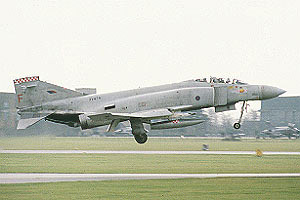 Delivered
in October 1978, XV474, coded 'F' with 56 Squadron, was the first RAF
aircraft to have what became known as an air-superiority scheme. Light
grey overall with miniature roundels and squadron emblems were tried,
before the final scheme was settled on which used a pale colour for the
emblems as well. But, 'esprit de corps' meant that within a short while
squadron emblems were back to normal size and colour, however.
Delivered
in October 1978, XV474, coded 'F' with 56 Squadron, was the first RAF
aircraft to have what became known as an air-superiority scheme. Light
grey overall with miniature roundels and squadron emblems were tried,
before the final scheme was settled on which used a pale colour for the
emblems as well. But, 'esprit de corps' meant that within a short while
squadron emblems were back to normal size and colour, however.
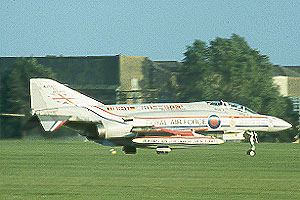 A
minor diversion was provided in 1979, when to commemorate the 60th anniversary
of the first transatlantic crossing, two aircraft from 56 Squadron were
painted in a special scheme and flown over the Atlantic, piloted by Flt
Lt Alcock (grandson of the original) and Flt Lt Browne. Flown into the
International Air Tattoo at Greenham Common, both of these aircraft were
somewhat unusual in having no serial markings, but were in fact XV424
and XV486.
A
minor diversion was provided in 1979, when to commemorate the 60th anniversary
of the first transatlantic crossing, two aircraft from 56 Squadron were
painted in a special scheme and flown over the Atlantic, piloted by Flt
Lt Alcock (grandson of the original) and Flt Lt Browne. Flown into the
International Air Tattoo at Greenham Common, both of these aircraft were
somewhat unusual in having no serial markings, but were in fact XV424
and XV486.
4 March 1982 also provided spotters some excitement when, while on 'bolthole' from nearby Honington, Buccaneer XW537 from 237 OCU stalled on finals and deposited itself, minus crew, neatly in two pieces in a field between the airfield and the village of Battisford.
Events some 16,000 miles away in the South Atlantic were to play an important role at the Station during 1983 and '84. With the conflict in the South Atlantic over, it became obvious that a fighter defence system would become vital, in case the Argentineans felt like chancing their arm again. So it was that 23 Squadron aircraft were ferried from Wattisham, flown by a selection of crews from all the air defence units, to become the deterrent in the South Atlantic. Eventually, the squadron was to lose its identity and be reduced to a flight of three aircraft, but initially it involved regular three month deployment of replacement crews to maintain the watch. Ground crew were the losers in the deployment stakes, in being away from home six months, not three.
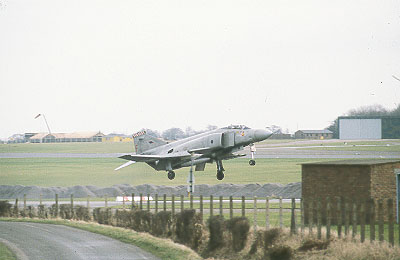 This
was going on at a time when hardened aircraft shelters (HAS) were also
being built on many bases. The construction of these had not yet started
when it fell once again to Foxtrot from 56 Squadron, to try out an emergency
landing system for the base. The short cross-runway was in poor state
of repair, and would certainly have given a 30-ton plus Phantom a problem
or two when forced to land there. So, one early winter’s morning
the minor road passing the base was closed to traffic (and spotters),
with no access allowed to the favourite Crash-gate 2 site, while an intrepid
air-crew carried out touch-and-goes on the perimeter track near the road.
Although no mishaps occurred, the building of HAS shelters, and the subsequent
use of this track for taxiing to the runway, probably precluded any further
use.
This
was going on at a time when hardened aircraft shelters (HAS) were also
being built on many bases. The construction of these had not yet started
when it fell once again to Foxtrot from 56 Squadron, to try out an emergency
landing system for the base. The short cross-runway was in poor state
of repair, and would certainly have given a 30-ton plus Phantom a problem
or two when forced to land there. So, one early winter’s morning
the minor road passing the base was closed to traffic (and spotters),
with no access allowed to the favourite Crash-gate 2 site, while an intrepid
air-crew carried out touch-and-goes on the perimeter track near the road.
Although no mishaps occurred, the building of HAS shelters, and the subsequent
use of this track for taxiing to the runway, probably precluded any further
use.
Slowly, through major servicing at St Athan, the Phantom fleet adorned an all-grey overcoat. This led to a very scruffy look to the aircraft when other than fresh from maintenance, as shoe-scuffed black marks from ground crew became the normal adornment to busy aircraft.
The loss of 23 Squadron to
the Falklands led to an increase in aircraft complement on 56 Squadron,
but reports of poor morale due to lack of rivalry on the station were
heard. Although never instigated for this reason, the idea of a two-unit
base always added that element of competition, which enabled crews to
hone their skills to the limit. Completion of hardened shelters led to
squadrons being sited as far away from each other as geographically possible
and Wattisham took on a totally new look, with one site adjacent to the
small industrial estate at Nedging Tye and the other to the west of the
airfield, nestling next to the small hamlet that lent its name to the
base. It had previously been instantly obvious to spotters whether the
base was active, with each 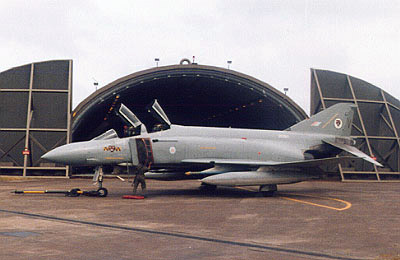 squadron
lining up the machines booked for flying on the day across the main operations
pan; when they towed them away, it was time to go home! The arrival of
HAS sites meant that no aircraft were visible on the ground until taxiing
to the runway. This ended the long-established practise of dispersing
fighters at points all over the airfield when on exercise or TACEVAL.
squadron
lining up the machines booked for flying on the day across the main operations
pan; when they towed them away, it was time to go home! The arrival of
HAS sites meant that no aircraft were visible on the ground until taxiing
to the runway. This ended the long-established practise of dispersing
fighters at points all over the airfield when on exercise or TACEVAL.
In 1984, the Government took one of the strangest decisions in the history of air defence. Loss of a squadron to the South Atlantic meant that the UK Air Defence Region was under pressure in the south of England. It was decided to purchase an entire squadron of second-hand Phantom F-4J, from storage in the USA. Ex-Navy machines, these were deemed to be the nearest to the F-4K and M, which equipped the RAF squadrons. Rumours beat the official machine in that this move would allow the re-instatement of a famous fighter unit, 74 Squadron – the Tigers. The squadron had laid dormant since disbanding in Singapore as a Lightning F6 unit attached to the FEAF.
On 30 August 1984, as the
sun dropped below the horizon, two 56 Squadron aircraft escorted the first
F-4Js into Wattisham. Horror struck as the new colour scheme became evident
– duck-egg green with tails adorned with a tiger. The final straw
was to see one aircraft, which had been delayed due to technical problems
in the US, arrive a few weeks later complete with an all-black fin. Consensus
was that this would never last, but 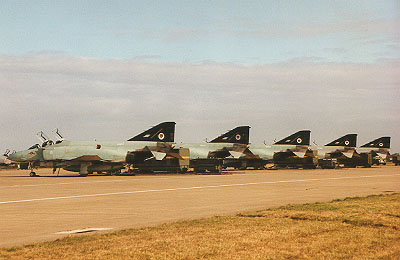 instead
of being removed, it became the model for the rest of the squadron and
before long all F-4Js were similarly adorned.
instead
of being removed, it became the model for the rest of the squadron and
before long all F-4Js were similarly adorned.
Several hardware clearance problems plagued 74 Squadron at first, but eventually the F-4J was recognised as the best of the three marks in service with the RAF (FG1, FGR2 and F-4J). Reheat response was said to be superior and manoeuvrability better. It soon therefore befell 74 to provide the Phantom demonstrator, the RAF having previously decided to remove this aircraft from the display scene. Unconnected was the early loss of one airframe, ZE358/H in a fatal crash in Wales during air to air exercises, this being the only F-4J lost, although one, ZE363/W, was rarely seen and became a 'hangar queen' for most of its life. During its relatively short service life the 'J proved to be a popular mount for Wattisham's crews, but political events elsewhere would bring about its untimely demise after seven years of service, more of which in part six.